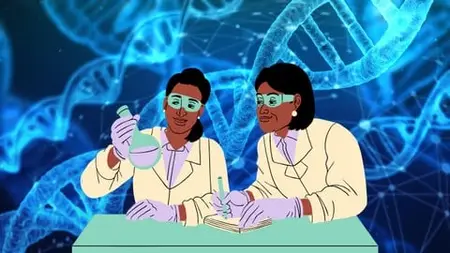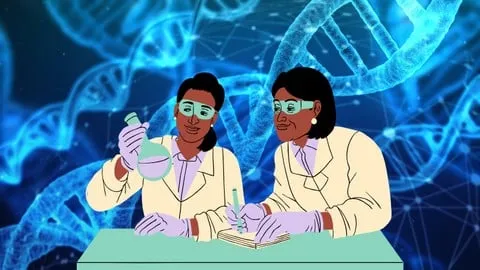Ultimate Biomaterials Course For Biomedical Engineers
Published 8/2025
MP4 | Video: h264, 1920x1080 | Audio: AAC, 44.1 KHz
Language: English | Size: 1.87 GB | Duration: 5h 48m
Published 8/2025
MP4 | Video: h264, 1920x1080 | Audio: AAC, 44.1 KHz
Language: English | Size: 1.87 GB | Duration: 5h 48m
Master biomaterials Fundamentals: In-Depth Learning of tissue engineering, metals, polymers, ceramics, and composites
What you'll learn
Understand the structure, properties, and classifications of biomaterials used in medicine.
Analyze biocompatibility and how materials interact with living tissues.
Compare metals, polymers, ceramics, and composites for biomedical applications.
Evaluate real case studies of implant success and failure.
Understand mechanical behavior: stress, strain, fatigue, and failure modes.
Explore tissue engineering, biodegradation, and regenerative medicine strategies.
Apply material science concepts to medical devices like stents, valves, and prostheses.
Learn how FDA regulations impact biomaterials design and approval.
Identify surface modifications to improve osseointegration and hemocompatibility.
Explain polymerization mechanisms and their impact on medical polymer properties.
Requirements
Some Chemistry would be useful, but not necessary.
Description
Learn everything you need to know about biomaterials — from molecular foundations to real-world medical devices. Whether you're a student, engineer, or healthcare professional, this comprehensive biomaterials course will give you the skills and knowledge to understand, evaluate, and apply biomaterials in medicine and biotechnology.In this course, you will explore every major category of biomaterials — metals, polymers, ceramics, composites, and biodegradable materials — with special focus on biocompatibility, mechanical behavior, surface properties, degradation, and clinical applications.You’ll also cover the biological side: human tissues, immune responses, and how implants integrate (or fail) in the body. Through engaging real-world case studies and failure analyses (like metal-on-metal hips or Teflon-coated implants), you'll see why material choice truly matters.Here's how the course is structured:Core principles: Materials science basics, solid state, and stress-strain behaviorMaterial-specific modules: Metals, polymers, ceramics, composites — structure, processing, applicationsBiological interaction: Tissue types, immune responses, biofilms, osseointegrationClinical applications: Heart valves, stents, prostheses, tissue engineering, 3D printingRegulatory insights: FDA pathways, material selection standards, safety concernsDesigned for beginners, this course combines theory, clinical relevance, and biomedical engineering insight.Enroll now to confidently master the science and applications of biomaterials — and bring your work or studies to the next level in biomedical innovation. See you in the course!
Overview
Section 1: Introduction to Biomaterials
Lecture 1 Introduction: Why Study Biomaterials?
Lecture 2 How the Body Reacts to Foreign Materials
Lecture 3 Real Case — Orthopedic Screws & Osteogenesis
Lecture 4 Real Case — How a Well-Designed Hip Prosthesis Works
Lecture 5 Failed Hip Prosthesis — When Materials Are Mismatched
Lecture 6 Material Failure & Infection Risk in Implants
Lecture 7 Patient-Specific Prostheses — The Custom Approach
Section 2: Regenerative Medicine & Tissue Engineering
Lecture 8 Tissue Engineering 101
Lecture 9 How Tissue Engineering Works — Step by Step
Lecture 10 Real Cases in Tissue Engineering
Lecture 11 Regenerative Medicine in Practice — Cartilage Repair
Section 3: Foundations of Biomaterials
Lecture 12 What Is a Material — and What Makes It a Biomaterial
Lecture 13 Biocompatibility
Lecture 14 How the Body Responds — and How Smart Biomaterials Work
Lecture 15 How We Classify Biomaterials
Lecture 16 Wear & Degradation in Biomedical Devices
Lecture 17 Bacterial Growth & Biofilms
Lecture 18 Aseptic Loosening
Lecture 19 Stress Shielding
Lecture 20 Controlled Drug Release Implants
Section 4: Solid Structures — The Big Picture
Lecture 21 States of Matter & The Solid State
Lecture 22 Types of Solids — Amorphous, Crystalline, Semi-crystalline
Lecture 23 Isotropy vs. Anisotropy
Lecture 24 Monocrystals & Polycrystals
Lecture 25 Unit Cells & Bravais Lattices
Lecture 26 Atomic Packing & Coordination
Lecture 27 Close-Packed Structures — FCC & HCP
Lecture 28 Ionic Solids — Structure & Properties
Lecture 29 Covalent, Molecular & Metallic Solids
Lecture 30 Layered & Chain Solids — Special Cases
Lecture 31 Real vs. Ideal Crystals — Why Defects Matter
Lecture 32 Point, Line & Surface Defects
Lecture 33 Defects & Mechanical Behavior
Lecture 34 Stress-Strain Behavior
Lecture 35 Stress-Strain Curve — Reading & Using It
Lecture 36 Fracture Modes — Tough vs. Fragile
Section 5: Relevant Human Tissues in Biomaterials
Lecture 37 The Extracellular Matrix — Nature’s Scaffold
Lecture 38 Collagen — The Body’s Structural Backbone
Lecture 39 Elastin — Flexibility and Energy Return
Lecture 40 Load-Bearing Tissues — Bone & Cartilage
Lecture 41 Special Tissues — Blood, Soft Tissues & Inflammation
Section 6: Stress Shielding in Hip Prostheses — Concepts & Design
Lecture 42 The Hip Joint — Function, Pathologies & Replacement
Lecture 43 What Is Stress Shielding_ — Bone Remodeling & Load Sharing
Lecture 44 How Implant Design Affects Stress Shielding
Lecture 45 Design Solutions to Minimize Stress Shielding
Biomedical engineering students looking to strengthen their foundation or prepare for advanced coursework.,Materials science and mechanical engineering students interested in applying their knowledge to medical and healthcare technologies.,Healthcare professionals, such as dentists, surgeons, or physiotherapists, seeking to understand the science behind implants, prosthetics, and tissue repair.,Medtech professionals and startup founders who want a reliable, structured overview of biomaterials for product development.,Anyone curious about how artificial joints, heart valves, sutures, or tissue scaffolds are made — and what makes them safe and effective.



